NHSScotland Chief Executive's Annual Report 2012/13
The NHSScotland Chief Executive's Annual Report 2012/13 presents an assessment of the performance of NHSScotland in 2012/13 and describes key achievements and outcomes.
Chapter 2 Improving Quality - A Summary of Progress
SUMMARY OF KEY ACHIEVEMENTS 2012/13
NHSScotland had another strong year in 2012/13, with the continued delivery of timely treatment for the people of Scotland. Alongside this, further and significant improvements were achieved in the delivery of services. The record of NHSScotland in this and earlier years has been recognised, with 87 per cent of people very or fairly satisfied with the quality of their local health services in 2012[4].
The advances made in the quality of health services mean NHSScotland is well positioned to deliver on our aim to be recognised as world-leading in the delivery of healthcare services. They demonstrate our commitment to adapt to the challenges and opportunities associated with an ageing population in Scotland and the need to respond to continued economic pressures. The achievements of NHSScotland include both specific progress towards the national targets agreed for 2012/13, and a wider range of improvements in the quality of services.
Each year, after extensive consultation, the Scottish Government sets performance targets for NHS Boards to ensure that the resources made available to them are directed to priority areas for improvement, consistent with the Government's Purpose and National Outcomes, and with the strategic direction set out in the Quality Strategy. These targets are focused on Health Improvement, Efficiency, Access and Treatment, and are known collectively as HEAT targets.
Our HEAT targets for NHSScotland set out the priorities for accelerated improvement to support the delivery of improved health and wellbeing outcomes for the people of Scotland. During 2012/13, NHSScotland continued to deliver notably strong performance against each of the safe, effective and person-centred Quality Ambitions with specific success in a number of areas:
- Sustained delivery of elective treatment waiting times, including the 18-week Referral to Treatment (RTT) waiting time standard and the introduction of the inpatient and day case Treatment Time Guarantee (TTG), which came into force on 1 October 2012;
- Maintaining fast treatment for cancer patients, with 97.8 per cent receiving treatment within 31 days of the decision to treat during the quarter ending March 2013, and 97.7 per cent during the quarter ending June 2013;
- Achieving significant reductions in levels of Healthcare Associated Infections (HAI), with a 7 per cent fall in the rate of Clostridium difficile amongst patients aged 65 and over in the year to June 2013 - contributing to a cumulative fall of 77 per cent since 2007/08. Rates of MRSA/MSSA fell by 3 per cent in the year to June 2013, as part of a 37 per cent reduction since 2007/08;
- Further reductions in levels of premature mortality (deaths for those aged under 75) across Scotland of 3 per cent in 2012 and 25 per cent since 2001;
- A reduction in the number of delayed discharges above 28 days to just 44 in April 2013, compared to 108 one year earlier and over 2,000 in April 2002;
- Delivery of faster Child and Adolescent Mental Health Services, with 96 per cent of patients treated within 26 weeks during the quarter ending March 2013 and 97 per cent in the quarter ending June 2013;
- Continued delivery of prompt treatment for patients with drug and alcohol problems. Almost 95 per cent of clients were treated within 3 weeks during the quarter ending March 2013, compared to 88 per cent one year earlier. 96 per cent of clients were treated within 3 weeks during the quarter ending June 2013;
- An increase in the proportion of stroke patients admitted to a stroke unit within one day of hospital admission to 80 per cent by quarter ending March 2013, compared to 68 per cent in 2010. Levels of stroke-related premature mortality fell by 6 per cent between 2011 and 2012;
- Delivery of a wide range of services targeting health improvement - with over 365,000 Alcohol Brief Interventions since 2008/09, including almost 95,000 during 2012/13. During the two years to 2012/13 over 48,000 people in Scotland's most deprived areas quit smoking (at one month) using NHSScotland smoking cessation services, delivering the associated HEAT target one year early;
- Further improvements in ambulance response times for those in greatest need, with 74.7 per cent of Category A calls responded to within 8 minutes during 2012/13, compared to 73 per cent one year earlier and 62 per cent in 2007/08;
- Achieving financial balance for every NHS Board;
- Reductions in deaths from stroke and Coronary Heart Disease (CHD) since 2001 of 43 and 46 per cent respectively, including a 4 per cent and 3 per cent reduction in 2012 alone. Whilst deaths from cancer remained stable in 2012, up by less than 1 per cent, overall cancer deaths have fallen 12 per cent since 2001; and
- Achieving a 10.7 per cent decrease in the rate of emergency bed days for patients aged 75 and over in 2012/13 compared with the 2009/10 target baseline. There were 5,535 occupied bed days per 1,000 over 75s in 2009/10 compared to 4,814 in 2012/13.
Information on progress towards all of the HEAT targets for NHSScotland is available for public scrutiny through the Scottish Government website 'Scotland Performs', including those targets referred to above[5]. This is updated on a continuous basis and includes both national and NHS Board level information.
HEAT TARGETS DUE IN 2012/13
| Target |
Latest Results |
|---|---|
| NHS Boards to operate within their agreed revenue resource limit; operate within their capital resource limit; meet their cash requirement. |
All Boards met their 2012/13 Financial Targets. |
| By March 2013, 90 per cent of clients will wait no longer than 3 weeks from referral received to appropriate drug or alcohol treatment that supports their recovery. |
In the quarter ending March 2013, 94.6 per cent of clients who had started their first treatment for drug or alcohol use had waited 3 weeks or less. This increased to 96 per cent for the quarter ending June 2013. |
| Deliver faster access to mental health services by delivering 26 weeks referral to treatment for specialist Child and Adolescent Mental Health Services (CAMHS) from March 2013; and 18 weeks referral to treatment for Psychological Therapies from December 2014. |
The initial estimates indicate that around |
| To improve stroke care, 90 per cent of all patients admitted with a diagnosis of stroke will be admitted to a stroke unit on the day of admission, or the day following presentation by March 2013. |
80 per cent of patients admitted with a diagnosis of stroke in the quarter ending March 2013 were admitted to a stroke unit within one day of admission. |
| Further reduce Healthcare Associated Infections so that by March 2013 NHS Boards' Staphylococcus aureus bacteraemia (including MRSA) cases are 0.26 or less per 1,000 acute occupied bed days; and the rate of Clostridium difficile infections in patients aged 65 and over is 0.51[6] cases or less per 1,000 total occupied bed days. |
For the year ending March 2013, the rate of Staphylococcus aureus bacteraemia (including MRSA) cases across NHSScotland was 0.30 per 1,000 acute occupied bed days. The rate remained at 0.30 for the year ending June 2013. The rate of identifications of CDI across NHSScotland was 0.37 per 1,000 occupied bed days among patients aged 65 and over. This rate fell to 0.35 for the year ending June 2013. |
| No people will wait more than 28 days to be discharged from hospital into a more appropriate care setting, once treatment is complete from April 2013; followed by a 14 day maximum wait from April 2015. |
There were 44 people waiting over 28 days to be discharged from hospital in April 2013, compared to 118 in July 2013. |
HEAT TARGETS DUE IN FUTURE YEARS
| Target |
Latest Results |
|---|---|
| Reduce suicide rate between 2002 and 2013 by 20 per cent. |
Between 2000/02 and 2010/12 the rate of suicide has decreased by 18 per cent, from 17.4 per 100,000 population to 14.3 per 100,000 population. |
| To achieve 14,910 Child Healthy Weight Intervention programmes over the three years ending March 2014. |
10,183 Child Healthy Weight Interventions delivered during 2011/12 and 2012/13. |
| NHSScotland to deliver universal smoking cessation services to achieve at least 80,000 successful quits (at one month post quit) including 48,000 in the 40 per cent most-deprived within-Board SIMD areas over the three years ending March 2014. |
89,353 successful one month quit attempts overall during 2011/12 and 2012/13, including 50,154 in the 40 per cent most deprived areas. |
| At least 60 per cent of 3 and 4 year olds in each SIMD quintile to have fluoride varnishing twice a year by March 2014. |
For the year ending March 2012, the worst-performing age/quintile combination at the national level was 6.1 per cent. |
| To increase the proportion of people diagnosed and treated in the first stage of breast, colorectal and lung cancer by 25 per cent by 2014/2015. |
In 2010/2011, 23 per cent of people with breast, colorectal and lung cancer in Scotland were diagnosed at stage 1 of the disease. |
| At least 80 per cent of pregnant women in each SIMD quintile will have booked for antenatal care by the 12th week of gestation by March 2015 so as to ensure improvements in breast feeding rates and other important health behaviours. |
For the year ending March 2012, the worst-performing SIMD quintile at the national level was 65.2 per cent. |
| NHSScotland to reduce energy-based carbon emissions and to continue a reduction in energy consumption to contribute to the greenhouse gas emissions reduction targets set in the Climate Change (Scotland) Act 2009. |
Between 2009/10 and 2012/13, NHSScotland secured a 7.9 per reduction in CO2 emissions and a 5.8 per cent reduction in energy consumption. |
| Eligible patients will commence IVF treatment within 12 months by 31 March 2015. |
Data for the target are currently under development, the first publication is planned |
| Deliver faster access to mental health services by delivering 26 weeks referral to treatment for specialist Child and Adolescent Mental Health Services (CAMHS) from March 2013; reducing to 18 weeks from December 2014; and 18 weeks referral to treatment for Psychological Therapies from December 2014. |
The initial estimates indicate that around 87 per cent of people were seen within 18 weeks during quarter ending June 2013. Waiting times information for Psychological Therapies is still at an early stage of development. The initial estimates from data at an early stage of development indicate that around 81 per cent of people were seen within 18 weeks during quarter ending June 2013 (excluding NHS Ayrshire & Arran and NHS Grampian). |
| 95 per cent of patients will wait less than 4 hours from arrival to admission, discharge or transfer for accident and emergency treatment by year ending September 2014. |
The percentage of patients waiting less than |
| To support shifting the balance of care, NHS Boards will achieve agreed reductions in the rates of attendance at A&E between 2009/10 and 2013/14. |
In the year ending June 2013, the number of unplanned A&E attendances per 100,000 population was 2,140 (the 2013/14 target is 2,095). |
| Further reduce Healthcare Associated Infections so that by March 2015 NHS Boards' Staphylococcus aureus bacteraemia (including MRSA) cases are 0.24 or less per 1,000 acute occupied bed days; and the rate of Clostridium difficile infections in patients aged 15 and over is 0.32 cases or less per 1,000 total occupied bed days. |
For the year ending June 2013, the rate of Staphylococcus aureus bacteraemia (including MRSA) cases across NHSScotland was 0.30 per 1,000 acute occupied bed days. The rate of identifications of CDI across NHSScotland was 0.35 per 1,000 occupied bed days among patients aged 15 and over. |
| No people will wait more than 14 days to be discharged from hospital into a more appropriate care setting, once treatment is complete from April 2015. |
There were 312 people waiting over 14 days to be discharged from hospital in July 2013. |
| Reduce the rate of emergency inpatient bed days for people aged 75 and over per 1,000 population by at least 12 per cent between 2009/10 and 2014/15. |
There was a 10.7 per cent decrease in the rate of occupied bed days for patients aged 75 and over in 2012/13 compared with the target baseline. There were 5,393 bed days per 1,000 population in 2009/10 compared to 4,814 in 2012/13. |
| To deliver expected rates of dementia diagnosis and by 2015/16, all people newly diagnosed with dementia will have a minimum of a year's worth of post-diagnostic support coordinated by a link worker, including the building of a person-centred support plan. |
Data systems and definitions are currently under development. |
LONGER TERM PROGRESS
The NHS became 65 years old on 5 July 2013, and this was an opportunity to celebrate the world-class care it delivers for the people of Scotland. Strong though the achievements of the NHS were in 2012/13, a longer term view is needed to demonstrate the continual and steady improvements which have been achieved. These improvements have resulted in better outcomes for the people of Scotland and create a firm foundation for the pursuit of our 2020 Vision for healthcare services.
One of the most significant achievements is the fall in premature mortality over the past 30 years, which has decreased by 48 per cent since 1981 (Chart 1). This includes a 25 per cent decrease since 2001 alone. Premature mortality, a key indicator of the health of Scotland's population, measures the death rates of those aged under 75. The rates are European age-standardised, in order that they take account of changes in the population distribution in Scotland over time. In 1981, there were 644 deaths for every 100,000 people aged under 75. That figure fell to 336 by 2012. Significant reductions in premature mortality were seen across all major causes of death since 2001, including cancer (down 18 per cent), diseases of the circulatory system (44 per cent) and heart disease (48 per cent). Over this period, life expectancy of both men and women has continually increased.
Chart 1
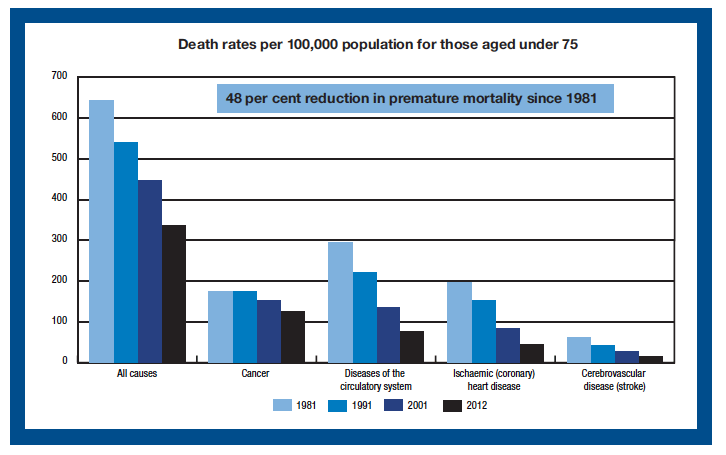
Source: National Records of Scotland: Under 75 Age Standardised Death Rates
One of the ways in which NHSScotland supports the people of Scotland is through its preventative work to encourage behavioural changes, which will ultimately lead to improved health outcomes. Smoking has an enormous influence on the health of people in Scotland, and NHSScotland has worked hard over many years to help people quit.
NHSScotland was set a three-year target to deliver 48,000 smoking quits (at one month) amongst people living in Scotland's most deprived areas by 2013/14. Such has been the level of activity secured by NHS Boards that the target has been delivered one year early, with 50,154 quits achieved by 2012/13.
Smoking rates fell from 30.7 per cent in 1999 to 22.9 per cent by 2012 (Chart 2). Rates also fell in Scotland's 40 per cent most deprived areas, from 41 per cent of the population smoking in 1999 to 32 per cent by 2012. As Scotland's rate of smoking remains high internationally and impacts disproportionately on those living in deprived areas, the unemployed and those unable to work due to short-term ill health, NHSScotland will continue to prioritise activity in this area.
Chart 2
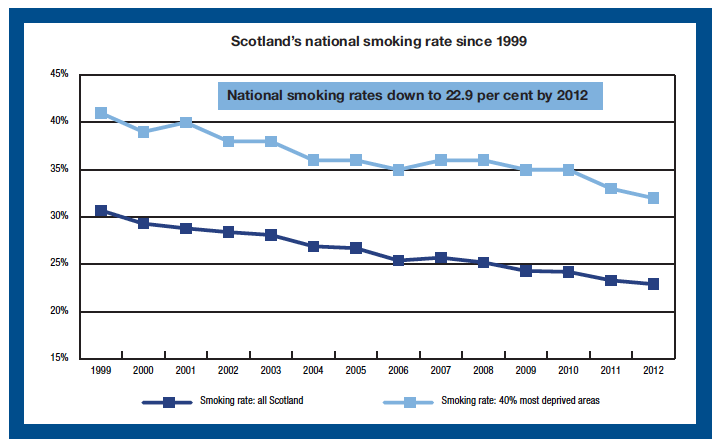
Source: Scottish Government: Scottish Household Survey
When NHS treatment is needed, shorter waits can lead to earlier diagnosis and better outcomes, as well as reducing unnecessary worry and uncertainty for patients and their relatives. The 18-week Referral to Treatment waiting time standard applies to the whole 'pathway' from referral up to the point the patient is treated. NHSScotland has continued to perform strongly in this area, with 91.6 per cent of patients commencing treatment within 18 weeks of referral during June 2013.
The significant progress made in reducing waiting times over previous years continued in 2012/13, with the introduction of the 12-week Treatment Time Guarantee (TTG) in October 2012. This ensures patients who are receiving planned treatment on an inpatient or day case basis will not wait longer than 12 weeks from the date that treatment is agreed. Over 200,000 patients had benefited from the Guarantee by June 2013.
Chart 3
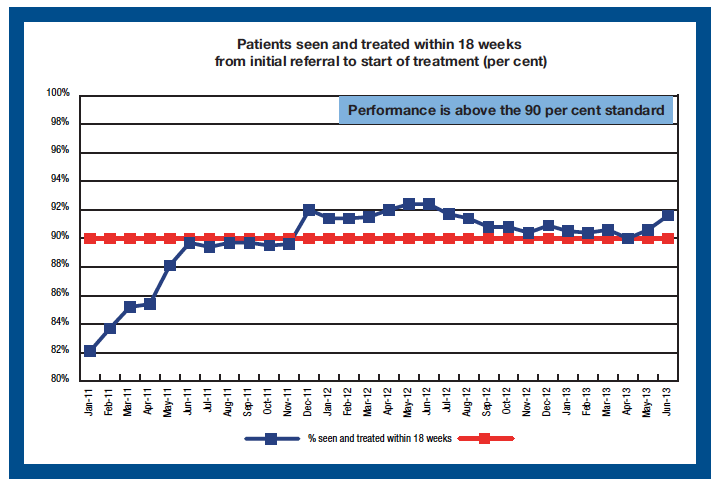
Source: ISD Scotland: Waiting Times 18-week Referral to Treatment, Waiting Times Data Warehouse
Sometimes NHS treatment is needed on an emergency (i.e. unplanned) basis. However for some older people an admission to hospital can be followed by complications such as a serious loss of confidence and confusion that prolong their stay, compromising their independence and ability to return home quickly.
While rehabilitation can minimise this risk it is important to prevent avoidable emergency admissions wherever possible and to enable older people to return home as soon as is safe and practicable. NHSScotland and its partners have worked hard over recent years to reduce the length of time older people stay in hospital following an emergency admission, with a 15 per cent reduction in the rate of emergency bed days for those aged 75 and over since 2002/03 (Chart 4). Since peaking at 2.176 million in 2008/09, the total number of emergency bed days for patients aged 75 and over has fallen by 7 per cent or almost 162,000 to 2.014 million by 2012/13. This is in the context of an increase of over 25,000 in the population aged 75 and over since 2008 and is the equivalent of freeing up 444 hospital beds on a daily basis throughout the entire year.
Chart 4
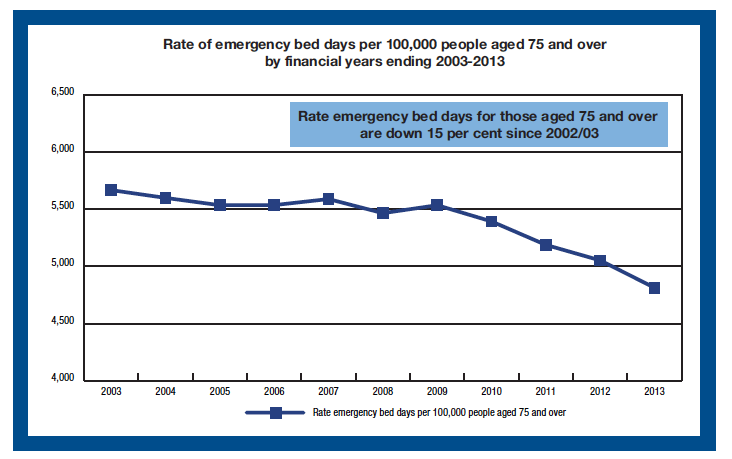
Source: ISD Scotland: SMR01 Dataset
Once people begin their treatment, they should expect the highest standard of quality and safety. One of the ways in which NHSScotland has sought to achieve this over a number of years is through reducing the level of Healthcare Associated Infections (HAI). These events can increase patient stays in hospital, leading to poorer outcomes. In 2007/08 there were 6,516 cases of Clostridium difficile amongst patients aged 65 and over, a rate of 1.54 cases per 1,000 occupied bed days (Chart 5). After a huge effort by NHS Boards and staff, this has reduced by 77 per cent to 1,292 cases in the year ending June 2013, or a rate of 0.35 cases per 1,000 bed days. NHSScotland is now working towards delivering further reductions, with a successor target seeking 0.32 cases per 1,000 occupied bed days for those aged 15 and over by 2014/15.
Chart 5
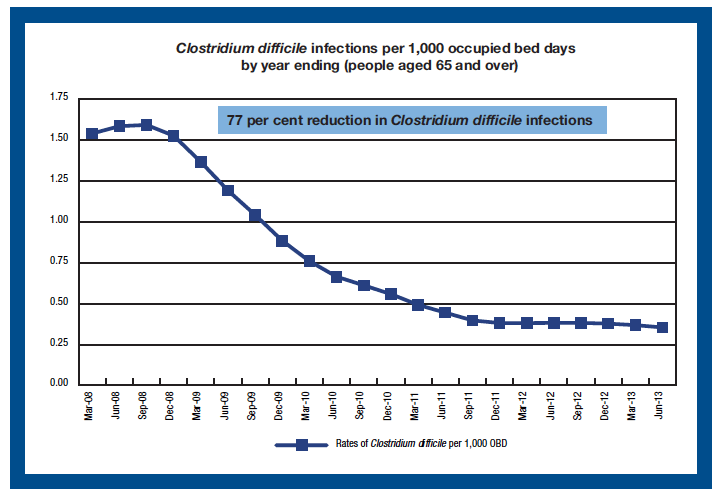
Source: Health Protection Scotland: Quarterly Report on CDI
Once patients are ready to be discharged from hospital, they should expect this to happen as soon as possible. Unnecessary delays contribute to a poorer experience for patients and are a waste of hospital resources. Such has been the success of NHSScotland and local authority partners during previous years in reducing delays of over six weeks that the focus in 2012/13 turned to reducing hospital delays of over 28 days. Back in April 2002, there were 2,268 patients delayed in hospital by over 28 days (Chart 6). By April 2013, that figure had reduced by no less than 98 per cent, to just 44. This success should also be seen in the context of growing numbers of older people in Scotland, with those aged 75 and over increasing by 6.4 per cent or over 25,000 since 2008 to 418,486 by 2012[7]. NHSScotland is now working to reduce delayed discharge even further, with a 14-day maximum wait for discharge to be achieved by April 2015.
Chart 6
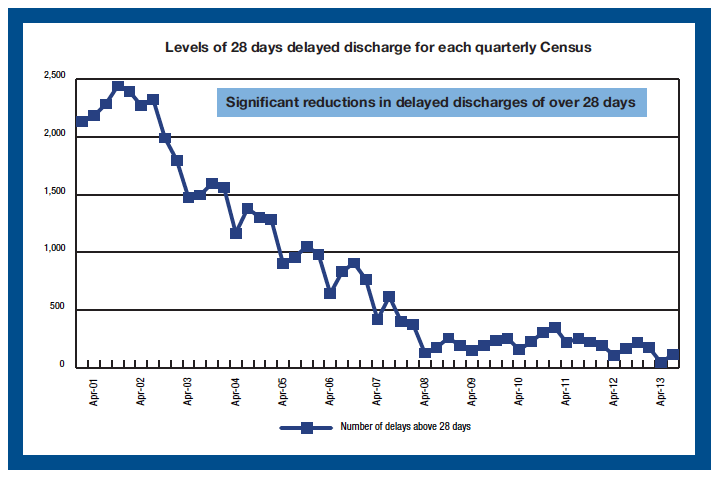
Source: ISD Scotland: Delayed Discharge
The direct experience of people who use the NHS in Scotland will always be crucial in determining how effectively services are being delivered. Patient experience surveys feed the experiences of the public into improvements in NHSScotland. The latest results from these surveys demonstrate that NHSScotland currently enjoys a favourable reputation amongst its users. In 2011/12, 85 per cent of inpatients and 89 per cent of GP patients rated their care as either good or excellent[8].
More recently, a survey of people's satisfaction with public services reported that 87 per cent were very or fairly satisfied with their local health services in 2012 (Chart 7). This remains very similar to 88 per cent in 2011 and is higher than the 81 per cent level recorded for 2007.
Chart 7
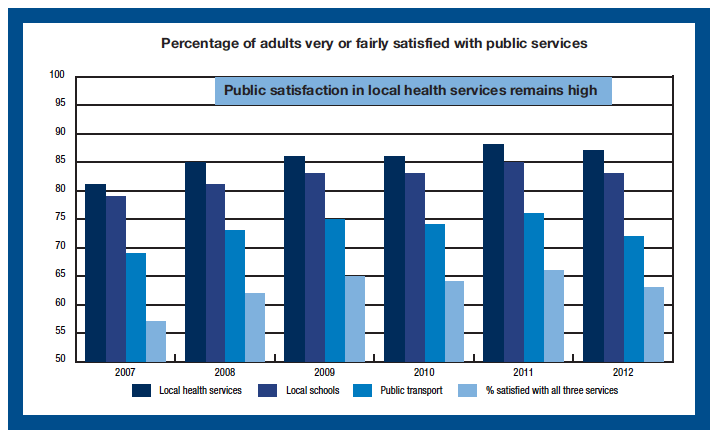
Source: Scottish Government: Scottish Household Survey
Contact
Email: Andrew Wilkie
There is a problem
Thanks for your feedback